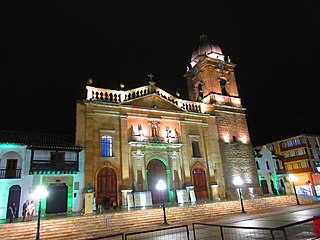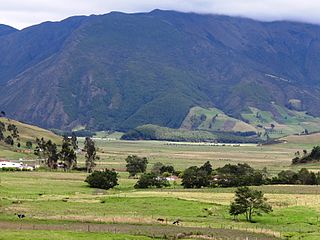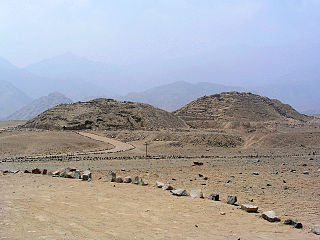| Look up Altiplano or altiplano in Wiktionary, the free dictionary. |
The Altiplano (Spanish for "high plain") is an Andean highland in Bolivia, Peru, and Chile.
Altiplano may also refer to:
| Look up Altiplano or altiplano in Wiktionary, the free dictionary. |
The Altiplano (Spanish for "high plain") is an Andean highland in Bolivia, Peru, and Chile.
Altiplano may also refer to:

Boyacá is one of the thirty-two departments of Colombia, and the remnant of Boyacá State, one of the original nine states of the "United States of Colombia".
The Music of Peru is an amalgamation of sounds and styles drawing on Peru's Andean, Spanish, and African roots. Andean influences can perhaps be best heard in wind instruments and the shape of the melodies, while the African influences can be heard in the rhythm and percussion instruments, and European influences can be heard in the harmonies and stringed instruments. Pre-Columbian Andean music was played on drums and string instruments, like the European pipe and tabor tradition. Andean tritonic and pentatonic scales were elaborated during the colonial period into hexatonic, and in some cases, diatonic scales.
Cumbia refers to a number of musical rhythms and folk dance traditions of Latin America, generally involving musical and cultural elements from Amerindians, Africans enslaved during colonial times, and Europeans. Examples include:
Bronze race is a term used since the early 20th century by Hispanic American writers of the indigenista and americanista schools to refer to the mestizo population that arose in the Americas with the arrival of Latin European settlers and their intermingling with the New World's Amerindian peoples.

Tunja is a city on the Eastern Ranges of the Colombian Andes, in the region known as the Altiplano Cundiboyacense, 130 km northeast of Bogotá. In 2018 it had a population of 172,548 inhabitants. It is the capital of Boyacá department and the Central Boyacá Province. Tunja is an important educational centre of well-known universities. In the time before the Spanish conquest of the Muisca, there was an indigenous settlement, called Hunza, seat of the hoa Eucaneme, conquered by the Spanish conquistadors on August 20, 1537. The Spanish city was founded by captain Gonzalo Suárez Rendón on August 6, 1539, exactly one year after the capital Santafé de Bogotá. The city hosts the most remaining Muisca architecture: Hunzahúa Well, Goranchacha Temple and Cojines del Zaque.

The Andean Parliament is the governing and deliberative body of the Andean Community. It was created on October 25, 1979 in La Paz (Bolivia), through the Constitutive Treaty signed by the chancellors of Bolivia, Colombia, Ecuador, Peru and Venezuela. It entered into force in January 1984.

The Altiplano Cundiboyacense[altiˈplano kundiβoʝaˈsense] is a high plateau located in the Eastern Cordillera of the Colombian Andes covering parts of the departments of Cundinamarca and Boyacá. The altiplano corresponds to the ancient territory of the Muisca. The Altiplano Cundiboyacense comprises three distinctive flat regions; the Bogotá savanna, the valleys of Ubaté and Chiquinquirá, and the valleys of Duitama and Sogamoso. The average altitude of the altiplano is about 2,600 metres (8,500 ft) above sea level but ranges from roughly 2,500 metres (8,200 ft) to 4,000 metres (13,000 ft).

Ráquira, is a municipality and town in Boyacá Department, Colombia, part of the subregion of the Ricaurte Province. Ráquira is situated on the Altiplano Cundiboyacense and the urban center at an altitude of 2,150 metres (7,050 ft). It borders Tinjacá and Sutamarchan in the north, Guachetá, Cundinamarca in the south, in the east Sáchica and Samacá and in the west San Miguel de Sema and Lake Fúquene.

Nemocón is a municipality and town of Colombia in the Central Savanna Province, part of the department of Cundinamarca. Nemocón, famous for its salt mine, was an important village in the Muisca Confederation, the country in the central Colombian Andes before the arrival of the Spanish. The municipality is situated in the northern part of the Bogotá savanna, part of the Altiplano Cundiboyacense with its urban centre at an altitude of 2,585 metres (8,481 ft) and 65 kilometres (40 mi) from the capital Bogotá. Nemocón is the northeasternmost municipality of the Metropolitan Area of Bogotá and the Bogotá River originates close to Nemocón. The median temperature of Nemocón is 12.8 °C. The municipality borders Tausa in the north, Suesca and Gachancipá in the east, Tocancipá and Zipaquirá in the south and in the west the rivers Checua and Neusa and the municipality of Cogua.

The Spanish language in South America varies within the different countries and regions of the continent. The term "South American Spanish" is sometimes used as a broad name for the dialects of Spanish spoken on the continent, but such a term is only geographical and has little or no linguistic relevance. Spanish is the most widely Spoken language of the South American continent, followed closely by Portuguese.
Patiño or Patino is a surname of Hispanic origin. The name refers to:
The Federal Social Readaptation Center No. 1 "Altiplano" is the maximum security federal prison of the Secretariat of Public Security in Mexico. This facility is located in the Santa Juana Centro neighborhood of Almoloya de Juárez, in the State of Mexico, 25 kilometers (16 mi) from Toluca.
Aymara may refer to:

Andean Baroque is an artistic movement that appeared in colonial Peru between 1680 and 1780. It is located geographically between Arequipa and Lake Titicaca in what is now Peru, where rules over the highlands and spreads over the entire altiplano. From the Portuguese word barrueco meaning impure, mottled, flamboyant, daring, the most striking example of Andean Baroque art is in religious architecture, where criollo and indigenous craftsmen together gave it a unique character, as happened in the New Spanish Baroque.

The Andean preceramic refers to the early period of human occupation in the Andean area of South America that preceded the introduction of ceramics. This period is also called pre-ceramic or aceramic.

The Herrera Period is a phase in the history of Colombia. It is part of the Andean preceramic and ceramic, time equivalent of the North American pre-Columbian formative and classic stages and age dated by various archaeologists. The Herrera Period predates the age of the Muisca, who inhabited the Altiplano Cundiboyacense before the Spanish conquest of the Muisca and postdates the prehistory of the region in Colombia. The Herrera Period is usually defined as ranging from 800 BCE to 800 CE, although some scholars date it as early as 1500 BCE.

Lake Herrera is a small lake located at 5 kilometres (3.1 mi) from the urban centre of Mosquera and about 20 kilometres (12 mi) west of the capital Bogotá in Cundinamarca, Colombia. The Andean lake has made its name in the Herrera Period, the period in the history of central Colombia before the Muisca Period, after archaeologist Sylvia Broadbent excavated ceramics around Lake Herrera in 1971.

The Paipa–Iza volcanic complex is a volcanic field of Late Pliocene to Early Pleistocene age on the Altiplano Cundiboyacense in the Eastern Ranges of the Colombian Andes. It is the northernmost volcanic complex of the Andean Volcanic Belt with Fueguino in Tierra del Fuego, Chile, at the opposite end of the Andean mountain belt.